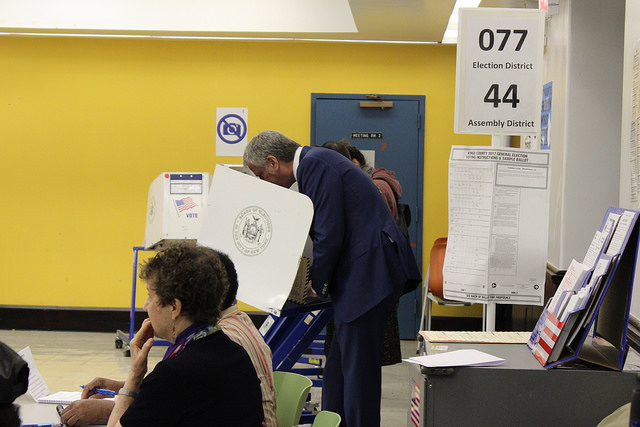
Mayor de Blasio voting (photo: Samar Khurshid/Gotham Gazette)
New York City Mayor Bill de Blasio recently announced a DemocracyNYC plan. One big goal: “to register 1.5 million New Yorkers to vote over the next four years.”
To make this work the mayor will create a new city leadership post: Chief Democracy Officer. How hard will it be for this new chief to meet the mayor’s goal?
Let’s do some rough math, based upon recent enrollment, census, and vital statistics data:
According to estimates in the most recent American Community Survey, there were 5,402,352 citizens of voting age in New York City in 2016 (plus or minus 22,325).
According to the state Board of Elections, in November of 2017 there were 5,053,842 registered voters in the city. That’s 93.5% of the eligible citizens.
Let’s make two initial assumptions to maximize the number of potential additional registrants among those of voting age now to make the CDO’s job more possible. First we’ll put aside reasons for disqualification other than age that would further reduce the number of those eligible but not registered (in prison or on parole for a felony, judged mentally incompetent by a court, voting elsewhere). Second, we’ll add that 22,325 to the estimate – that is, make the high side assumption of the number of age- eligible citizens while remaining within the statistical range of error.
That results in 370,835 citizens who are of voting age now and not registered.
Additionally, there are about 372,000 teenagers in New York City who will reach the age of 18 in the next four years. Of all people in the city over the age of 18, about four in five (80.5%) are citizens. The percentage of citizens among younger people, many born here of immigrant parents, is likely higher. They are not all citizens, but again let’s count more rather than fewer as likely to be eligible to register to vote: 9 in 10 of them. That would be 334,800.
That brings the available target total of potential new registrants to 705,635.
People from elsewhere in the country or living abroad (but not new immigrants) will move into and out of the city during the mayor’s second term. For now let’s just consider those moving in. Some will be children. Some won’t be citizens. A high side assumption from past experience of the number who can be registered: 200,000.
That brings us to 905,635 potential registrants.
Uh oh. We are 594,365 short.
Of course there are all those people who move within the city. They change their addresses. They need to re-register. Maybe the mayor meant to include them; he did not say the Chief Democracy Officer would have to find “new” registrants. So let’s give him the benefit of the doubt. Again we have to watch out for kids, non-citizens, and those already included in our count as not registered. Estimating from federal statistics on people moving annually within and between counties for 2011-2015, it looks like 483,000 is a reasonable number.
Still not there: 1,388,022 (OK, though, we’re getting within shouting distance). To meet the mayor’s goal the Chief Democracy Officer must find about 112,000 more people eligible to register in the next four years, and register them all. Where?
But wait a minute, that’s just the additions. How about the subtractions?
The Empire Center and others have noted that New York City’s population continues to grow every year because immigrants from abroad outnumber the many already living here who are leaving. Less noticed, most of those leaving are voters or vote-eligible, while those who are arriving are non-citizens. A conservative estimate is that 189,000 actual or potential registrants will move out of the city over the next four years.
Finally, there’s mortality. About 212,000 New Yorkers will die during Mayor de Blasio’s second term, more than 95% of whom are voting age. Of course, some - probably a smaller portion than for the city population as a whole - will be non-citizens. A reasonable, conservative estimate is that death will reduce New York City’s potential electorate by 171,000.
One-hundred-eighty-nine thousand plus 171,000 equals 360,000. Departure and mortality will reduce the city’s potential electorate in the next four years by about 6.5%.
Implications:
-Registering 1.5 million people to vote in New York City over the next four years is an impossible dream.
-Registering all of the age-eligible citizens now in the city won’t significantly expand the current electorate; it will keep it about the same size.
-The largest pool of potential registrants during Mayor de Blasio’s second term is comprised of people living in the city who are already registered, but changed their addresses.
-It would be truly extraordinary if the city’s voting roles grew by half-a-million registrants in the next four years.
The bottom line: If I were asked to be the new Chief Democracy Officer, the first thing I’d do is some serious counting. Then I’d call the mayor, to renegotiate the voter registration goal.
***
Gerald Benjamin is Director of The Benjamin Center at SUNY New Paltz.
***
Have an op-ed idea or submission for Gotham Gazette? Email This email address is being protected from spambots. You need JavaScript enabled to view it.




